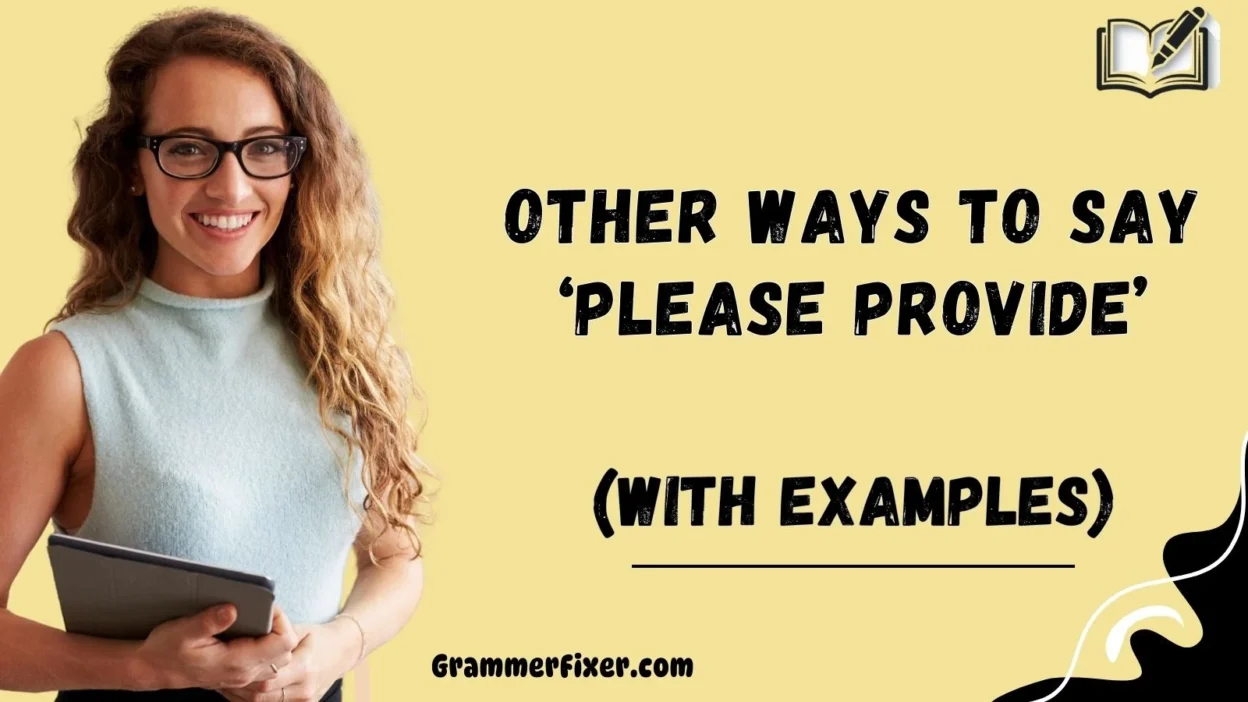Finding the right words when making requests is an important skill in both professional and personal communication. The phrase “please provide” is clear and direct, but sometimes it can feel too formal, abrupt, or repetitive if used too often. By using thoughtful alternatives, you can convey respect, foster cooperation, and make your messages feel more personal and considerate.
Let’s explore 30 alternatives that can help you enhance your communication skills, demonstrate professionalism, and ensure your requests are well-received.
What Does “Please Provide” Mean?
The phrase “please provide” is a polite way of asking someone to give or share something—whether it’s information, documents, assistance, or specific items. It is widely understood and commonly used in professional settings, particularly in emails, official instructions, or workplace communication.
When to Use “Please Provide”?
You should use “please provide” when you want to:
- Make a direct yet courteous request
- Ask for documents, details, or assistance
- Maintain a professional tone in business communication
- Ensure clarity in formal correspondence
Is It Professional/Polite to Say “Please Provide”?
Yes, “please provide” is both professional and polite. However, depending on the context, urgency, and relationship with the recipient, it may sometimes come across as stiff, robotic, or overly formal. Adjusting your tone and phrasing can help balance professionalism with warmth.
Pros or Cons
Pros:
- Clear and concise
- Universally understood
- Works well in formal settings
- Helps avoid misunderstanding
Cons:
- Can sound abrupt if overused
- May feel impersonal in sensitive situations
- Doesn’t always reflect warmth or collaboration
1. Kindly Provide
Meaning: A softer, more considerate version of “please provide.”
Detailed Explanation: Adding “kindly” introduces warmth and makes the request feel gentler and more respectful.
Scenario Example:
“Could you kindly provide the updated financial figures by Friday?”
Best Use: In emails to colleagues, clients, or senior managers where a polite, formal tone is needed.
Worst Use: In casual or informal chats with coworkers, as it may feel unnaturally stiff.
Tone: Polite, respectful, and considerate
2. Could You Please Send
Meaning: A polite request that combines courtesy with action.
Detailed Explanation: Using “could you” makes the request feel like a question rather than a command.
Scenario Example:
“Could you please send the revised project timeline by tomorrow?”
Best Use: In team communication when asking for documents or updates.
Worst Use: In urgent or time-sensitive requests, as it may sound too soft and slow.
Tone: Polite, professional, approachable
3. Would You Mind Sharing
Meaning: A gentle, softer way of asking someone to provide something.
Detailed Explanation: This phrasing suggests collaboration and shows you’re mindful of the recipient’s time.
Scenario Example:
“Would you mind sharing the latest draft of the proposal?”
Best Use: When addressing colleagues, clients, or external partners where you want to avoid sounding demanding.
Worst Use: In strictly formal or legal communication, where the tone may feel too casual or uncertain.
Tone: Friendly, collaborative, respectful
4. May I Ask You to Provide
Meaning: A formal, courteous phrase often used in official correspondence.
Detailed Explanation: This request emphasizes respect and professionalism.
Scenario Example:
“May I ask you to provide the signed contract at your earliest convenience?”
Best Use: In legal, compliance, or senior-level communication.
Worst Use: In casual workplace chats, as it may come across as overly formal or distant.
Tone: Formal, professional, respectful
5. Grateful If You Could Supply
Meaning: A thankful and professional way of requesting.
Detailed Explanation: Expresses appreciation upfront while requesting.
Scenario Example:
“I’d be grateful if you could supply the vendor contact details.”
Best Use: When you want to show gratitude in advance.
Worst Use: In urgent situations, as it may feel too slow or indirect.
Tone: Polite, appreciative, professional
6. At Your Earliest Convenience, Please Send
Meaning: A polite request with an emphasis on timeliness.
Detailed Explanation: Highlights urgency while still sounding respectful.
Scenario Example:
“Could you at your earliest convenience, please send the finalized report?”
Best Use: When deadlines are important but you want to remain courteous.
Worst Use: For very urgent needs (same-day delivery), because the phrase is too vague about timing.
Tone: Professional, time-sensitive, polite
7. I Would Appreciate It If You Could Provide
Meaning: Adds gratitude and softens the directness of the request.
Detailed Explanation: This phrasing emphasizes consideration and appreciation.
Scenario Example:
“I would appreciate it if you could provide the updated project budget by Monday.”
Best Use: In both formal and semi-formal communication where gratitude is important.
Worst Use: In quick back-and-forth emails, as it can feel wordy and overly formal.
Tone: Warm, professional, thoughtful
8. Please Forward
Meaning: A direct but polite alternative when requesting emails or documents.
Detailed Explanation: Works best for email communication when passing along files.
Scenario Example:
“Please forward the meeting minutes to the participants.”
Best Use: In workplace communication where efficiency is key.
Worst Use: In sensitive or diplomatic contexts, where it may sound too abrupt.
Tone: Professional, concise
9. Kindly Furnish
Meaning: A formal, business-like version of “please provide.”
Detailed Explanation: Often used in contracts, legal documents, or official requests.
Scenario Example:
“Please kindly furnish the required compliance documents by end of the week.”
Best Use: In legal or official correspondence.
Worst Use: In everyday emails, as it can sound outdated and overly stiff.
Tone: Formal, authoritative, professional
10. Can You Please Share
Meaning: A simple, polite, and approachable request.
Detailed Explanation: The word “share” makes it feel less transactional and more collaborative.
Scenario Example:
“Can you please share the presentation slides for tomorrow’s meeting?”
Best Use: When requesting from colleagues, peers, or collaborators.
Worst Use: In hierarchical communication with senior executives, as it may sound too casual.
Tone: Friendly, respectful, engaging
11. Please Submit
Meaning: A direct and professional way to request official documents or forms.
Detailed Explanation: Commonly used in workplace communication, academic, or regulatory contexts.
Scenario Example:
“Please submit the finalized expense report by Friday.”
Best Use: In formal contexts like HR, compliance, or project documentation.
Worst Use: In casual communication with coworkers, as it can sound too commanding.
Tone: Professional, authoritative, straightforward
12. Would You Kindly Send
Meaning: A formal yet courteous variation of “please provide.”
Detailed Explanation: Combines politeness with formality, often seen in emails and letters.
Scenario Example:
“Would you kindly send the updated project plan at your earliest convenience?”
Best Use: When addressing clients, external vendors, or senior colleagues.
Worst Use: In urgent situations, as it may feel too soft and deferential.
Tone: Polite, formal, considerate
13. Please Share With Me
Meaning: A friendly and approachable way of requesting.
Detailed Explanation: By adding “with me,” it feels personal and engaging.
Scenario Example:
“Could you please share with me the marketing proposal draft?”
Best Use: When requesting something from teammates or collaborators.
Worst Use: In formal reports or legal contexts, where it sounds too casual.
Tone: Warm, approachable, conversational
14. I’d Be Obliged If You Could Provide
Meaning: A very polite and formal way of making a request.
Detailed Explanation: Expresses humility and respect, often found in traditional business or legal English.
Scenario Example:
“I’d be obliged if you could provide the finalized vendor quotations.”
Best Use: In formal letters or old-style correspondence.
Worst Use: In modern workplace emails, as it may seem archaic or overly formal.
Tone: Respectful, traditional, formal
15. Do Send
Meaning: A short and encouraging version of a request.
Detailed Explanation: Works in friendly exchanges where brevity is appreciated.
Scenario Example:
“Do send the presentation slides once ready.”
Best Use: In informal or semi-formal exchanges with colleagues you know well.
Worst Use: In official instructions or senior-level communication, as it may sound too casual or abrupt.
Tone: Encouraging, informal, light
16. Feel Free to Provide
Meaning: A gentle, non-demanding way of requesting input or details.
Detailed Explanation: Makes the request optional-sounding, useful for encouraging contribution.
Scenario Example:
“Feel free to provide your feedback on the proposal draft.”
Best Use: In brainstorming sessions, collaboration, or casual team exchanges.
Worst Use: In strict deadlines or mandatory submissions, where it may cause confusion about importance.
Tone: Open, collaborative, casual
17. Please Furnish Me With
Meaning: A formal synonym for “please provide.”
Detailed Explanation: More common in contracts, legal, and bureaucratic communication.
Scenario Example:
“Please furnish me with the official board approval documents.”
Best Use: In contracts, legal agreements, or highly formal letters.
Worst Use: In day-to-day team communication, as it may feel outdated and stiff.
Tone: Formal, legal, professional
18. I’d Appreciate Your Supplying
Meaning: A thankful, formal request that stresses gratitude.
Detailed Explanation: Emphasizes respect and shows appreciation in advance.
Scenario Example:
“I’d appreciate your supplying the quarterly financial statements by Tuesday.”
Best Use: In business correspondence where courtesy matters.
Worst Use: In casual team chats, as it may feel too formal for quick requests.
Tone: Appreciative, formal, thoughtful
19. Do Forward
Meaning: A brief, semi-formal command-like request for sending items.
Detailed Explanation: Works best when time is short and the recipient already expects the request.
Scenario Example:
“Do forward the signed contract once it’s ready.”
Best Use: In short reminders to colleagues.
Worst Use: In client-facing or sensitive emails, where it may seem too blunt.
Tone: Direct, brief, semi-formal
20. Can I Request You to Provide
Meaning: A polite phrasing that softens the act of asking.
Detailed Explanation: Shows respect and frames the request as a favor.
Scenario Example:
“Can I request you to provide the project updates for this week?”
Best Use: In professional but respectful communication.
Worst Use: In urgent or high-pressure contexts, as it may feel too hesitant.
Tone: Polite, respectful, deferential
21. Please Deliver
Meaning: A direct and professional request for a physical or digital handover.
Detailed Explanation: Often used when expecting something to be formally sent, transferred, or completed.
Scenario Example:
“Please deliver the updated proposal to the client by Friday.”
Best Use: In formal communication with vendors, suppliers, or service providers.
Worst Use: In casual workplace communication, where it may sound too commanding or transactional.
Tone: Professional, formal, direct
22. Kindly Submit
Meaning: A polite and professional synonym of “please provide.”
Detailed Explanation: Common in corporate emails, HR notices, or academic requests.
Scenario Example:
“Kindly submit the signed forms before the deadline.”
Best Use: In structured environments where compliance is expected.
Worst Use: In friendly team chats, as it may feel overly stiff.
Tone: Polite, formal, courteous
23. Please Supply
Meaning: A straightforward way to request items or information.
Detailed Explanation: Clear and direct, works well in procurement, logistics, and business communication.
Scenario Example:
“Please supply the latest figures for the financial report.”
Best Use: In official requests for resources or data.
Worst Use: In creative brainstorming sessions, where it may sound too transactional.
Tone: Direct, professional, businesslike
24. Would You Be Able to Provide
Meaning: A polite, tentative way of asking for something.
Detailed Explanation: Softens the request, giving the recipient the impression of choice and flexibility.
Scenario Example:
“Would you be able to provide the updated schedule by tomorrow?”
Best Use: When asking colleagues or superiors without being forceful.
Worst Use: In urgent, deadline-driven situations, as it may sound too hesitant.
Tone: Respectful, gentle, polite
25. Please Make Sure to Send
Meaning: A polite reminder that emphasizes responsibility.
Detailed Explanation: Useful when ensuring that a task is completed correctly and on time.
Scenario Example:
“Please make sure to send the updated client list by Monday.”
Best Use: For team reminders or accountability checks.
Worst Use: In sensitive, high-level communication, as it can sound slightly commanding.
Tone: Polite, firm, responsible
26. I’d Be Thankful If You Could Share
Meaning: Expresses gratitude in advance while making the request.
Detailed Explanation: Adds warmth and appreciation to keep the request gentle and considerate.
Scenario Example:
“I’d be thankful if you could share the product launch insights.”
Best Use: In collaborative team settings or when asking for voluntary input.
Worst Use: In strict business or compliance requests, where gratitude can feel excessive.
Tone: Warm, polite, thoughtful
27. Please Ensure You Provide
Meaning: A firm yet polite reminder with a sense of obligation.
Detailed Explanation: Stronger than “please provide,” useful when accuracy and deadlines are critical.
Scenario Example:
“Please ensure you provide the completed forms before submission.”
Best Use: In official instructions or compliance-heavy communication.
Worst Use: In casual settings, where it may sound too strict or bossy.
Tone: Firm, professional, authoritative
28. Can You Kindly Send
Meaning: A polite variation of “please send.”
Detailed Explanation: Balances directness with courtesy, often used in email communication.
Scenario Example:
“Can you kindly send me the final version of the proposal?”
Best Use: When requesting files, documents, or updates from colleagues.
Worst Use: In legal or high-stakes documents, where it may appear too soft.
Tone: Polite, approachable, semi-formal
29. Please Attach
Meaning: A direct request for files or documents in an email.
Detailed Explanation: Efficient and clear when referencing digital communication.
Scenario Example:
“Please attach the revised draft to your next email.”
Best Use: In emails where attachments are required.
Worst Use: In formal letters or verbal communication, as it is too specific to email context.
Tone: Professional, concise, practical
30. Kindly Forward
Meaning: A polite alternative for requesting someone to send something onward.
Detailed Explanation: A softer way of saying “please forward,” more common in formal or diplomatic correspondence.
Scenario Example:
“Kindly forward the meeting agenda to the team.”
Best Use: In professional communication with clients or external contacts.
Worst Use: In casual workplace chats, where it may feel unnaturally formal.
Tone: Polite, formal, professional
Conclusion
The phrase “please provide” is a universally understood, professional request, but overusing it can make your communication feel robotic or impersonal. By diversifying your vocabulary with these 30 thoughtful alternatives, you can:
- Match the tone to the situation
- Avoid sounding abrupt or repetitive
- Show gratitude and warmth when needed
- Convey urgency politely
- Maintain professionalism and respect



